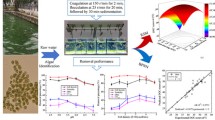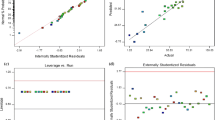Abstract
Introduction
Due to the population growth and reduction of water resources, wastewater treatment and reuse vital. As the secondary wastewater treatment processes enable removes a significant amount of P and N, nutrient-rich effluents can cause eutrophication in water bodies. On the other hand, nutrients removal in sewage treatment using mechanical methods is costly and complex. The aquaculture method using Azolla filiculoides could be an appropriate option for removing total phosphorus (TP), total nitrogen (TN), and chemical oxygen demand (COD) from wastewater.
Materials and methods
Synthetic wastewater has been prepared in the typical range of municipal wastewater. Two g fresh weight of an acclimatized A.filiculoides was floated in sample bowls each one containing 500 CC prepared wastewater. Total nitrogen, TP, and COD removal by Azolla filiculoides for 21-days were optimized and investigated using the response surface methodology (RSM). For this aim, the D-optimal method was used to optimize the three independent variables (TP concentration (10.8–84.6 mg l− 1), TN concentration (20–99 mg l− 1), and COD concentration (66.26–415 mg l− 1)) for their maximum removal efficiency of them. Experiments were performed on 28 runs in which independent variables were measured using a HACH DR 5000 spectrometer.
Results
Predicted R-squared for COD, TP, TN removal, and Azolla mass (responses) have been equal to -0.0897, 0.8514, 0.7779, and 0.5645, respectively. The model was used to maximize Azolla growth and maximize removal efficiency of nitrogen, phosphorus, and COD that occurred in minimum concentrations of TN (20 mg l− 1), TP (10.8 mg l− 1), and COD (66.26 mg l− 1). The removal efficiency of Azolla was obtained 77.5 % for COD, 66.8 % for TP, and 78.1 % for TN in the optimum condition of independent variables. Also, increase of Azolla mass was 239 %, with desirability of 0.66. The difference between model prediction and model validation testing for Azolla mass increase, COD, TN, and TP removal was equal to ± 11.6 %, ± 7.9 %, ± 0.0 %, and ± 1.9 %, respectively.
Conclusions
Azolla could remove phosphorus in nitrogen deficiency or even lack of nitrogen. Results indicate that removal efficiency has an upward trend as the Azolla growth increases. This kind of fern has a significant effect on removing nitrogen, phosphorus, and COD from an aqueous solution. The removal efficiency of TN, TP, and COD at optimum operating conditions showed good agreement with model-predicted removal efficiency.





Similar content being viewed by others
References
Mahdavi M, Naseri S, Yunesian M, Mahvi A, Alimohaadi M. Investigation of indirect contact freezing process in desalination of Boshehr Beach’s saline water. Iran J Health Environ. 2011;4(3):363–74.
Moghaddam VK, Changani F, Mohammadi A, Hadei M, Ashabi R, Majd LE, et al. Sustainable development of water resources based on wastewater reuse and upgrading of treatment plants: a review in the Middle East. Desalin Water Treat. 2017;65:463–73.
Alinezhadian A, Karimi A, Mohammadi J, Nikookhah F. Study of soil bacterial and crop quality irrigated with treated municipal wastewater. Iran J Health Environ. 2013;6(3):365–76.
Costa M, Santos M, Carrapiço F, Pereira A. Azolla–Anabaena’s behaviour in urban wastewater and artificial media–Influence of combined nitrogen. Water Res. 2009;43(15):3743–50.
Amare E, Kebede F, Mulat W. Wastewater treatment by Lemna minor and Azolla filiculoides in tropical semi-arid regions of Ethiopia. Ecol Eng. 2018;120:464–73.
Forni C, Nicolai M, D’Egidio MG. Potential of the small aquatic plans azolla and lemna for nitrogenous compounds removal from wastewater. Transac Ecol Environ. 2001;49:315–24.
Dohaei M, Karimi K, Rahimmalek M, Satari B. Integrated biorefinery of aquatic fern Azolla filiculoides for enhanced extraction of phenolics, protein, and lipid and methane production from the residues. J Clean Prod. 2020;276:123175.
Hussner A. NOBANIS–invasive alien species fact sheet–Azolla filiculoides 2010 [Access date: 2017/06/21].
Miranda AF, Biswas B, Ramkumar N, Singh R, Kumar J, James A, et al. Aquatic plant Azolla as the universal feedstock for biofuel production. Biotechnol Biofuels. 2016;9(1):221.
Golzary A, Tavakoli O, Rezaei Y, Karbassi A. Wastewater treatment by Azolla Filiculoides: A study on color, odor, COD, nitrate, and phosphate removal. Pollution. 2018;4(1):69–76.
Janes R. Growth and survival of Azolla filiculoides in Britain I. Vegetative production. New Phytol. 1998;138(2):367–75.
Abraham G, Dhar DW. Induction of salt tolerance in Azolla microphylla Kaulf through modulation of antioxidant enzymes and ion transport. Protoplasma. 2010;245(1–4):105–11.
Muradov N, Taha M, Miranda AF, Kadali K, Gujar A, Rochfort S, et al. Dual application of duckweed and azolla plants for wastewater treatment and renewable fuels and petrochemicals production. Biotechnol Biofuels. 2014;7(1):30.
Raut V, Shaikh I, Naphade B, Prashar K, Adhapure N. Plant growth promotion using microbial IAA producers in conjunction with azolla: a novel approach. Chemi Biol Technol Agric. 2017;4(1):1.
Huggins D. Evaluation of Azolla plant as an alternative stock feed source. Shepparton: Goulburn Broken Catchment Authority; 2007.
Anitha KC, Rajeshwari YB, Prasanna SB, Shree JS. Nutritive evaluation of Azolla as livestock feed. J Exp Biol Agric Sci. 2016;4(6):670–4.
Bilgin M, Şimşek İ, Tulun Ş. Treatment of domestic wastewater using a lab-scale activated sludge/vertical flow subsurface constructed wetlands by using Cyperus alternifolius. Ecol Eng. 2014;70:362–5.
Dalu J, Ndamba J. Duckweed based wastewater stabilization ponds for wastewater treatment (a low cost technology for small urban areas in Zimbabwe). Phys Chem Earth, Parts A/B/C. 2003;28(20):1147-60.
Anandha Varun R, Kalpana S. Performance analysis of nutrient removal in pond water using Water Hyacinth and Azolla with papaya stem. Int Res J Eng Technol. 2015;2(1):444–8.
Tokhun N, Boonthai, C. Wastewater treatment from piggery farm by usingAzolla (Azolla microphylla). 2011. Available from: https://www.semanticscholar.org/paper/Wastewater-treatment-from-piggery-farm-by-using-(-)-Tokhun-Boonthai/eae04fff2d85bdbebe026ec21413bfb48f841875.
Costa ML, Santos MC, Carrapiço F. Biomass characterization of Azolla filiculoides grown in natural ecosystems and wastewater. Biol Ecol Manag Aquat Plants. Berlin: Springer; 1999. pp. 323–7.
Sivakumar D, Nouri J. Removal of contaminants in a paper mill effluent by Azolla caroliniana. Glob J Environ Sci Manag. 2015;1(4):297–304.
Zazouli MA, Mahdavi Y, Bazrafshan E, Balarak D. Phytodegradation potential of bisphenolA from aqueous solution by Azolla Filiculoides. J Environ Health Sci Eng. 2014;12(1):66.
Lo K. Nutrien Solution Recipes. On-line). http://planttc.cfans.umn.edu/listserv/2002/log0202/msg00278.htmldiakses; 2008. Accessed 21 Jun 2017.
Kumar M, Mishra P, Upadhyay S. Pyrolysis of Saccharum munja: Optimization of process parameters using response surface methodology (RSM) and evaluation of kinetic parameters. Bioresour Technol Rep. 2019;8:100332.
Sahu J, Acharya J, Meikap B. Optimization of production conditions for activated carbons from Tamarind wood by zinc chloride using response surface methodology. Bioresour Technol. 2010;101(6):1974–82.
DESIGN-EXPERT® VERSION 11 SOFTWARE. Available from: https://www.statease.com/.
DR5000 Spectrophotometer Procedures Manual. Germany. 2005. Available from: https://www.hach.com/procedures-manual-dr-5000-uv-vis-spectrophotometer-cd-rom/product?id=7640314125
Pouil S, Samsudin R, Slembrouck J, Sihabuddin A, Sundari G, Khazaidan K, et al. Effects of shading, fertilization and snail grazing on the productivity of the water fern Azolla filiculoides for tropical freshwater aquaculture. Aquat Bot. 2020;160:103150.
Zazouli MA, Mahdavi Y, Bazrafshan E, Balarak D. Phytodegradation potential of bisphenolA from aqueous solution by Azolla Filiculoides. J Environ Health Sci Eng. 2014;12(1):1–5.
Ghobrial M, Siam E. The use of the water velvet Azolla filiculoides in wastewater treatment. Water Environ J. 1998;12(4):250–3.
Bauer B, Topić A, Kralj S, Kožuh Z. Influence of the gas composition on the geometry of laser-welded joints in duplex stainless steel. Materi Tehnol. 2011;45(5):413–9.
Khodadad Hosseini E, Derakhshi P, Rabbani M, Mooraki N. Pollutants removal from dairy wastewater using live Azolla filiculoides in batch and continuous bioreactors. Water Environ Res. 2021. https://doi.org/10.1002/wer.1586.
Sabetraftar K, Zarkami R, Sadeghi R, Van Damme P. A review of some ecological factors affecting the growth of Azolla spp. Caspian J Environ Sci. 2013;11(1):65–76.
Acknowledgements
The authors like to acknowledge the Zanjan University of Medical Sciences for their financial support of this project with N. A-12-124-5. The ethics committee has ethically approved this university with the registration code number of ZUMS.REC.1393.232.
Author information
Authors and Affiliations
Corresponding author
Ethics declarations
Conflict of interest
The authors of this article declare that they have no conflict of interest.
Additional information
Publisher’s note
Springer Nature remains neutral with regard to jurisdictional claims in published maps and institutional affiliations.
Rights and permissions
About this article
Cite this article
Taghilou, S., Peyda, M. & Mehrasbi, M.R. Modeling of wastewater treatment by Azolla filiculoides using response surface methodology. J Environ Health Sci Engineer 19, 1723–1733 (2021). https://doi.org/10.1007/s40201-021-00727-5
Received:
Accepted:
Published:
Issue Date:
DOI: https://doi.org/10.1007/s40201-021-00727-5




